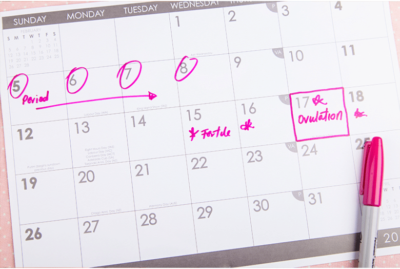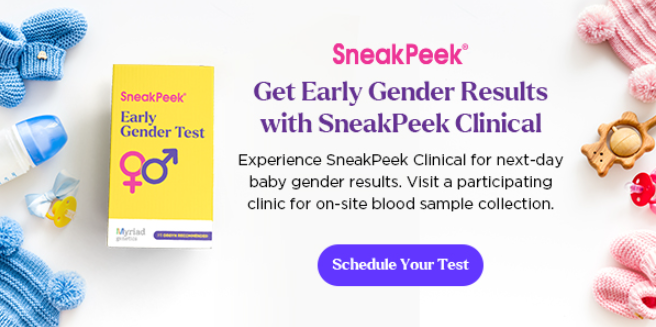Published on January 28th, 2025
Check out SneakPeek Gender Test to find out your baby’s gender as early as 6 weeks with over 99% accuracy!

Once upon a time, you may have Googled “when is the best time to have sex to avoid pregnancy”—oh, how times change!
After exploring fertility questions like what a good AMH level is, the next step is baby making. If you and your partner have been working towards starting a family, identifying when to have sex to get pregnant is the first step in getting pregnant. For most female reproductive cycles, there are 5 to 7 days when sperm and egg are primed for a meet-cute; this period is known as your fertile window.
Several strategies can help you calculate your fertile window, though factors like irregular menstrual cycles and stress can sometimes throw reproductive rhythms out of whack. Knowing how to time your “conception sessions” (as well as when to seek help from a fertility counselor) can help you optimize your chances of getting a YES on that pregnancy test. So, how do you know when you are able to turn those dreams about a baby girl or boy into a reality?
What is a fertile window?
In the simplest terms, your fertile window is the time during your month-to-month reproductive cycle when you’re most likely to get pregnant. It includes:
- 5 to 6 days preceding ovulation
- The day you ovulate
After an egg is dispatched from an ovary, it’s only viable for 12 to 24 hours—sperm won’t be able to fertilize it after that.
On the other hand, sperm can live for up to 5 days inside your body. So, if sperm are in your reproductive tract in the days leading up to your ovulation date, it’s possible you’ll become pregnant.
How can I find my fertile window?
As a general rule, most females ovulate around 2 weeks before their menstrual cycle resets (where your first day bleeding is day 1). If your cycle lasts 28 days, this would make your fertile window between days 9 and 15 (i.e., the optimal time for having sex!).
That said, reproductive cycles can vary in length, so it can help to spend a few months tracking how long your cycles are. For reference, a “normal” cycle length is considered between 21 and 35 days. If your cycles tend to be the same length from month to month, you’ll have an easier time gauging your fertile window.
Importantly, it’s thought that up to a quarter of American females have irregular menstrual cycles, which can make cycle lengths different from month to month. If this sounds like you, your ovulation date might be more difficult to pinpoint.
In this case, you might consider some alternative methods of predicting ovulation.
Method 1: Ovulation Predictor Kits
At-home technology has made it much easier to predict when ovulation occurs. Ovulation predictor kits measure the presence of LH (luteinizing hormone) in your urine, which shoots up around 1 or 2 days before you ovulate. Tracking ovulation is a straightforward way to figure out that window of fertile days.
Ovulation predictor kits are affordable and can be purchased online. To use them effectively, you’ll need to test your urine on a daily basis in the days preceding your predicted ovulation.
Method 2: Basal Body Temperature Tracking
Your basal body temperature is the temperature your body reaches in a state of perfect rest. Similar to LH, your BBT surges on the day you ovulate due to a marked increase in progesterone.
Tracking your basal body temperature can take a bit of work because:
- You can’t use a regular thermometer – You’ll need a special BBT thermometer, which is slightly more refined than your average pharmacy-bought ones.
- You’ll have to get up early – For a few months, you’ll need to take your temperature every morning before you get out of bed and start your day. With a few months of data, you’ll get a better sense of your fertile days, when you ovulate, and how to time conception attempts with your partner.
To make the process easier, know that some BBT thermometers sync with an app on your phone that automatically logs your temperature daily (saving you the trouble of manually logging your temperature every day!).
Method 3: Cervical Mucus Tracking
Your cervical mucus, commonly called “discharge,” has a special texture when you are fertile: it appears clear and stretchy and feels slippery. This consistency makes it easier for sperm to move up the cervix and reach your egg.
If you notice this kind of cervical mucus in your underwear, it’s likely you’ve reached prime time to try for a baby. Tracking your cervical mucus over the course of a few months can also give you a better sense of when your fertile window occurs.
Factors Impacting Your Fertile Window Timing
While some inconsistency between cycles is normal, other factors are often at work if your irregular periods are persistent or disruptive to your life and/or sexual health.
For instance, a period that disappears for 3 months or longer can’t be included under the umbrella of “irregular”—this is known as amenorrhea, and it’s usually a sign that something is amiss.
Whether your menstrual irregularity is mild or severe, if it’s interfering with your ability to clock your fertile window (or live your life), consider consulting with a healthcare provider. In the meantime, it can help to get a sense of what lifestyle and medical factors may be interfering with your fertility cycles.
Certain Medications
Some medicines are known for interfering with female fertility cycles. The most common are:
- Hormonal birth control
- Antidepressants
- Antipsychotics
- Thyroid medications
- Hormone medications
- Blood thinners
- Chemotherapy
If you’re on any of these types of medicines and experiencing issues with irregularity, don’t stop taking them. Instead, reach out to your healthcare provider about your family planning. They can help you determine whether the medication could be contributing to your menstrual irregularities (and potentially offer an alternative medication that won’t interfere with your ability to conceive).
Medical Conditions
Several reproductive or hormonal conditions can cause menstrual irregularity. These include:
- Polycystic ovary syndrome (PCOS)
- Endometriosis
- Pelvic inflammatory disease (PID)
- Thyroid disorders
- Pituitary gland disorders
- Certain cancers (although this is rare)
Sometimes, irregular periods can be caused by primary ovarian insufficiency or other challenges to fertility. If you’ve been trying to get pregnant for a while with no luck, it may be worth reaching out to a specialist to undergo fertility testing with your partner.
Stress
When the body is under stress, healthy reproductive functioning can get thrown off. In essence, your body knows you’re under pressure, and it’s a tall order to grow and raise a child under those conditions.
With that, any emotional, physical, or financial chronic pressure may make it more difficult to gauge your fertile window or conceive.
If you’ve been contemplating adopting a lower-stress lifestyle, trying for a baby could be an excellent opportunity to do so.
How to Optimize Your Chances of Pregnancy
While maternal age is a decisive factor when it comes to a person’s ability to conceive, plenty of lifestyle factors also play a role in fertility. To that end, it can be helpful to prioritize your overall health to optimize your chances of conception.
You can start by keeping an eye on:
- Nutrition – Ideally, both hopeful parents will aim for a balanced diet rich in whole foods. Micronutrients are also important—folic acid and iron, in particular, are believed to play a role in enhancing fertility and reproductive well-being.
- Moving regularly – People with active lifestyles tend to have better fertility outcomes than those with inactive ones. However, people trying to get pregnant should avoid frequent, intense exercise. If you’re a gym lover, aim to scale back to fewer than 1 hour a day and 5 per week of hard exercise. Now is also an excellent time to try out milder forms of exercise, like gentle yoga, nature walks, or slower-paced pilates.
- Destructive habits – Whether alcohol or tobacco, excessive substance abuse is linked to poorer fertility outcomes. If you imbibe these substances, consider toning down your use of them while you’re trying to get pregnant.
- Environmental toxins – Some studies have shown troubling data on the link between toxic environmental agents and male and female infertility. It may help put your mind at ease to do what you can to eliminate the prime offenders from your midst: try to reduce your exposure to pesticides, heavy metals, and other endocrine disruptors.
Sometimes, even minor lifestyle changes can relieve the mental pressure many hopeful parents put on themselves on the way to growing their families. These habits are great to stick with to support a healthy pregnancy once you see that positive test! Learning about your reproductive health (like how to increase your AMH level) can help you support your body on this journey. Fertility herbs for pregnancy as well as vitamins to get pregnant fast, can be beneficial to explore. Just check in with your doctor before starting anything new.
With patience, effort, and (if you need it!) guidance from a PCP or fertility specialist, you can feel confident about taking the first step on your journey.

Discover All Things Fertility with SneakPeek®
Starting parenthood on sound footing is always a matter of awareness—whether it’s knowing when to try for a baby, or getting some clues to who your baby is in advance. With the SneakPeek Early Gender DNA Test®, you can learn your baby’s fetal sex as early as 6 weeks into your pregnancy, with over 99% clinically proven accuracy and DNA-based results.
SneakPeek is the #1 OBGYN-recommended at-home early fetal sex test, with the support of over 1 million parents behind it. Share the news of your future baby’s sex sooner than ever by ordering yours today.
Editorial Policy
At SneakPeek, our commitment is to provide accurate, up-to-date, and reliable information to empower our readers. Our content is thoroughly researched, reviewed by medical experts, and fact-checked to ensure its credibility. We prioritize the well-being and education of our readers, and our editorial policy adheres to the highest standards of integrity and accuracy in all our articles.
This post has been reviewed for accuracy by:
Priscilla Jeng is an accomplished digital marketing expert, currently leading as the Associate Director of Digital Marketing at Gateway Genomics, the parent company of SneakPeek. With over four years at Gateway Genomics, Priscilla has played a pivotal role in amplifying the company's mission to develop innovative genetic tests. Her proficiency in digital marketing and her comprehensive understanding of the genomics industry position her as a key contributor to SneakPeek's marketing endeavors.
Sources:
- Johns Hopkins Medicine. Calculating Your Monthly Fertility Window. https://www.hopkinsmedicine.org/health/wellness-and-prevention/calculating-your-monthly-fertility-window
- Healthline. How to Predict Your Fertile Window and Use It to Help Get Pregnant. https://www.healthline.com/health/fertility/predict-fertile-window#fertile-window
- Mayo Clinic. Menstrual cycle: What’s normal, what’s not. https://www.mayoclinic.org/healthy-lifestyle/womens-health/in-depth/menstrual-cycle/art-20047186
- National Institutes of Health. What are menstrual irregularities? https://www.nichd.nih.gov/health/topics/menstruation/conditioninfo/irregularities
- Cleveland Clinic. Irregular Periods. https://my.clevelandclinic.org/health/diseases/14633-abnormal-menstruation-periods#symptoms-and-causes
- Verywell Mind. Can Medication Affect Your Period? https://www.verywellhealth.com/can-medication-affect-your-period-8646448
- Mayo Clinic. Female fertility: Why lifestyle choices count. https://www.mayoclinic.org/healthy-lifestyle/getting-pregnant/in-depth/female-fertility/art-20045887
- National Library of Medicine. Environmental Toxins and Infertility. https://www.ncbi.nlm.nih.gov/pmc/articles/PMC6396757/
- Medical News Today. What does the LH surge mean for pregnancy?
- https://www.medicalnewstoday.com/articles/322954
- Healthline. 16 Natural Ways to Boost Fertility. https://www.healthline.com/nutrition/16-fertility-tips-to-get-pregnant
- Fertility Family. Micronutrients and Fertility. https://www.fertilityfamily.co.uk/blog/micronutrients-and-fertility/
- Medical News Today. What to know about cervical mucus and fertile discharge. https://www.medicalnewstoday.com/articles/323503







